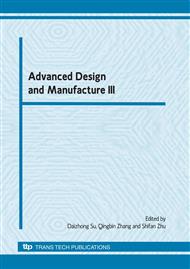p.47
p.51
p.55
p.59
p.63
p.67
p.71
p.75
p.79
Viscosity Influence Research on Load Capacity of Heavy Hydrostatic Bearing
Abstract:
Lubricant viscosity is one of the key parameters in hydrostatic bearing research. In order to solve the load capacity of hydrostatic bearing in the heavy equipment, viscosity-temperature equation of lubricant film is established, and the viscosity-temperature curve is fitted by B-Spline curve. Finite volume method is used on numerical simulation of pressure field of heavy hydrostatic bearing in constant and variable viscosity respectively and in different rotational velocity, whereafter, viscosity influence on load capacity of heavy hydrostatic bearing is discussed. The results show that, viscosity impose a minor influence on cavity pressure of hydrostatic bearing when rational velocity is low; whereas, when rational velocity is high, especially to the heavy hydrostatic bearing which with high liner velocity influence of viscosity changing must be taken into account in calculation. Numerical simulation results reflect the pressure distributing state of bearing veritably; furthermore, these provide theoretical basis for hydrostatic bearing design and lectotype in practical application.
Info:
Periodical:
Pages:
63-66
Citation:
Online since:
November 2010
Authors:
Price:
Сopyright:
© 2011 Trans Tech Publications Ltd. All Rights Reserved
Share:
Citation:


